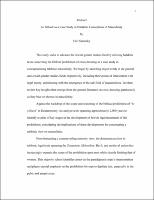Please use this identifier to cite or link to this item:
https://hdl.handle.net/20.500.12202/8195| Title: | Lo Yilbash as a Case Study in Halakhic Conceptions of Masculinity |
| Authors: | Hidary, Richard Irshai, Ronit Rynhold, Daniel Sinensky, Tzvi |
| Keywords: | Judaic studies Gender studies Cross-Dressing Gender Halakhah Jewish Law Jewish Studies Masculinity |
| Issue Date: | May-2022 |
| Publisher: | ProQuest Dissertations & Theses Global |
| Citation: | Sinensky, T. (2022, May). Lo Yilbash as a Case Study in Halakhic Conceptions of Masculinity. (Publication No. 29212539) [Doctoral dissertation, Yeshiva University] ProQuest Dissertations & Theses Global. |
| Series/Report no.: | ProQuest Dissertations & Theses Global;Publication No. 29212539 |
| Abstract: | This study seeks to advance the Jewish gender studies field by utilizing halakhic texts concerning the biblical prohibition of cross-dressing as a case study in conceptualizing rabbinic masculinity. We begin by sketching major trends in the general and Jewish gender studies fields respectively, including their points of intersection with legal theory, culminating with the emergence of the sub-field of masculinities. We then review key insights that emerge from the general literature on cross-dressing, particularly as they bear on themes in masculinity. ¶ Against the backdrop of the scope and reasoning of the biblical prohibition of “lo yilbash” in Deuteronomy, we analyze texts spanning approximately 2,000 years to identify a series of key stages in the development of Jewish legal treatments of this prohibition, considering the implications of these developments for constructing a rabbinic view on masculinity. ¶ Notwithstanding a countervailing minority view, the dominant position in rabbinic legal texts spanning the Targumim, Midrashim, Bavli, and medieval authorities increasingly expands the scope of the prohibition upon men while sharply limiting that of women. This majority school identifies armor as the paradigmatic men’s ornamentation and places special emphasis on the prohibition for men to depilate hair, especially in the pubic and armpit areas. ¶ Early modern halakhic literature ushers in a “return to reciprocity” between men and women’s prohibitions alongside a new emphasis on the role of intention. This culminates in the 19th-century literature, which emphasizes distinct gender roles as the basis for lo yilbash, returning to what contemporary scholars increasingly see as the most likely explanation for the biblical prohibition. Finally, seeking to combat the rising influence of the feminist movement in Orthodoxy, numerous contemporary halakhic authorities reverse the earlier trend, dramatically expanding the scope of lo yilbash as it applies to women. ¶ Notwithstanding these significant variations throughout halakhic history, numerous rulings concerning cross-dressing utilize lo yilbash to combat an underlying “anxious masculinity,” to discourage men from pursuing physical beauty, and to encourage them to reclaim the image of the warrior male. Rabbinic treatments of lo yilbash thus provide key data points in an attempt to reconstruct a larger picture of rabbinic views on masculinity |
| Description: | Doctoral dissertation, PhD / OA |
| URI: | https://hdl.handle.net/20.500.12202/8195 https://ezproxy.yu.edu/login?url=https://www.proquest.com/dissertations-theses/em-lo-yilbash-as-case-study-halakhic-conceptions/docview/2676608378/se-2 |
| Appears in Collections: | Bernard Revel Graduate School of Jewish Studies: Doctoral Dissertations |
Files in This Item:
| File | Description | Size | Format | |
|---|---|---|---|---|
| Sinensky May2022 OA Lo Yibash Revel R.pdf | 1.54 MB | Adobe PDF |  View/Open |
This item is licensed under a Creative Commons License

